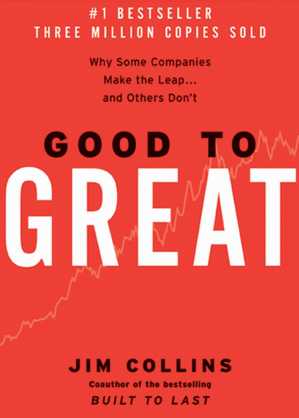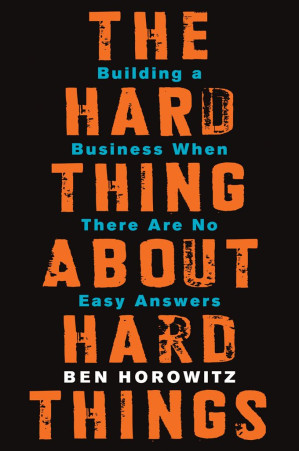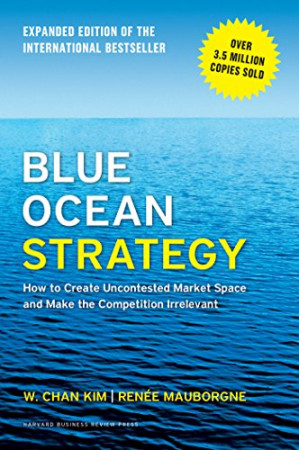Level 5 Leadership: Humility + Will = Great Results
Level 5 leaders display a powerful mixture of personal humility and indomitable will.

Book summary
by Jim Collins
Why Some Companies Make the Leap... and Others Don't
Research-based analysis of how good companies become great
Topics
Read one principle per week and use Readever to document how each concept applies to your organization. After each chapter, identify one specific action to implement the Hedgehog Concept or Level 5 Leadership in your team. Set reminders to review your progress and use Readever's AI to translate Collins' research into practical strategies for your specific business context.
Things to know before reading
Good to Great presents the findings from a five-year research study examining why some companies make the leap from good to great while others don't. Jim Collins and his team identified 11 companies that achieved sustained greatness and discovered the universal principles that drove their transformation, including Level 5 Leadership, the Hedgehog Concept, and the Flywheel Effect.
Collins' research revealed six core principles that distinguish great companies from merely good ones. Each concept builds on the others to create a framework for sustainable excellence.
Level 5 leaders display a powerful mixture of personal humility and indomitable will.
Great companies first get the right people on the bus (and the wrong people off) before figuring out where to drive it.
Retain faith that you will prevail in the end, regardless of the difficulties, AND confront the most brutal facts of your current reality.
The hedgehog knows one big thing and sticks to it, while the fox knows many things but lacks focus.
When you combine a culture of discipline with an ethic of entrepreneurship, you get the magical alchemy of great performance.
Great companies avoid technology fads, but become pioneers in the application of carefully selected technologies.
Greatness comes from pushing in a consistent direction over an extended period, building momentum like a giant, heavy flywheel.
Ready to continue? Launch the Readever reader and keep turning pages without paying a cent.

Michael E. Gerber
Transform from technician to entrepreneur by building systems, not just working

Ben Horowitz
Practical wisdom for navigating the toughest challenges in building companies

W. Chan Kim & Renée Mauborgne
Create uncontested market space and make competition irrelevant

Clayton M. Christensen
Why great companies fail when faced with disruptive technologies
This summary gives you the blueprint for building enduring greatness in your organization. You'll learn how to identify the right people, focus on what you can be best at, and build momentum through disciplined action—avoiding the common pitfalls that keep companies stuck at mediocrity.
Key idea 1
Level 5 leaders display a powerful mixture of personal humility and indomitable will.
The most surprising finding from the research was the type of leadership required for greatness. Level 5 leaders are self-effacing, quiet, and reserved—the opposite of the charismatic, celebrity CEOs often celebrated in business media. They channel their ambition into the company's success rather than personal glory, taking responsibility for failures while giving credit to others for successes. These leaders build enduring greatness through a paradoxical blend of personal humility and professional will.
Remember
Key idea 2
Great companies first get the right people on the bus (and the wrong people off) before figuring out where to drive it.
Before setting strategy or vision, great companies focus on getting the right people in the right seats. They rigorously apply the principle of "first who, then what"—ensuring they have disciplined people who don't need to be managed before determining direction. This approach creates a culture where the right people are self-motivated, reducing the need for excessive management and enabling the organization to adapt more easily to changing circumstances.
Remember
Key idea 3
Retain faith that you will prevail in the end, regardless of the difficulties, AND confront the most brutal facts of your current reality.
Named after Admiral Jim Stockdale's survival strategy in a Vietnamese POW camp, this principle involves maintaining unwavering faith while confronting harsh realities. Great companies create a climate where truth is heard, encourage dialogue and debate, conduct autopsies without blame, and build red flag mechanisms. They don't sugarcoat problems but face them head-on while maintaining confidence in eventual success.
Remember
Key idea 4
The hedgehog knows one big thing and sticks to it, while the fox knows many things but lacks focus.
Great companies operate according to the Hedgehog Concept—finding the intersection of three circles: what you can be the best in the world at, what drives your economic engine, and what you are deeply passionate about. This simple, crystalline concept provides focus and eliminates distractions. Companies that achieve greatness simplify complex reality into a single organizing idea that guides all their decisions.
Remember
Key idea 5
When you combine a culture of discipline with an ethic of entrepreneurship, you get the magical alchemy of great performance.
Great companies build a culture of discipline where people don't need hierarchy, bureaucracy, or excessive controls. They hire self-disciplined people who don't need to be managed, then give them freedom within the framework of the Hedgehog Concept. This disciplined culture enables entrepreneurship and innovation while maintaining focus and consistency.
Remember
Key idea 6
Great companies avoid technology fads, but become pioneers in the application of carefully selected technologies.
Great companies don't chase technology for technology's sake. Instead, they become pioneers in applying carefully selected technologies that directly support their Hedgehog Concept. They use technology as an accelerator of momentum, not a creator of it. The key is thoughtful, deliberate adoption of technologies that align with the company's core strengths.
Remember
Key idea 7
Greatness comes from pushing in a consistent direction over an extended period, building momentum like a giant, heavy flywheel.
Transformation from good to great doesn't happen overnight or through a single defining action. It comes from pushing in a consistent direction over time, building momentum incrementally like turning a massive flywheel. Each push, no matter how small, adds to the cumulative momentum. The breakthrough comes when momentum kicks in and the flywheel begins to spin on its own.
Remember
Good to Great is the result of a rigorous five-year research project that examined why some companies make the leap from good performance to great results while others don't. Jim Collins and his research team identified 11 companies that achieved this transformation and sustained it for at least 15 years, outperforming the market by an average of 6.9 times.
The book systematically analyzes the factors that distinguish great companies from merely good ones, focusing on leadership, strategy, culture, and discipline. Through comparative analysis with companies that failed to make the leap, Collins identifies universal principles that apply across industries and time periods.
The research methodology was exceptionally rigorous, involving massive data collection, interviews with executives, and careful comparison with control companies. The findings challenge conventional wisdom about what drives corporate success and provide a practical framework for building enduring greatness.
Open Readever's reader to highlight passages, ask the AI companion questions, and keep exploring without paying a cent.
Good to Great stands as one of the most influential business books of the 21st century, combining rigorous research with practical insights. Collins' methodology—comparing companies that made the leap with those that didn't—provides compelling evidence for his conclusions. The book's concepts have become part of the business lexicon, with terms like "Level 5 Leadership" and "Hedgehog Concept" entering mainstream management thinking.
What makes the book particularly valuable is its counterintuitive nature. Many findings contradict conventional business wisdom, such as the discovery that charismatic leaders often hinder rather than help the transition to greatness. The emphasis on discipline, focus, and humility provides a refreshing alternative to the celebrity CEO culture that dominated business thinking in the late 20th century.
The writing is clear and accessible, with memorable metaphors that make complex concepts easy to understand and apply. While some critics question whether the companies studied have maintained their greatness over time, the core principles remain relevant for any organization seeking sustainable excellence.
CEOs and senior executives leading organizational transformation
Entrepreneurs building companies for long-term success
Managers and team leaders developing high-performance cultures
Investors evaluating company leadership and potential
Anyone interested in the science of organizational excellence
Jim Collins is a student and teacher of what makes great companies tick, having spent more than 25 years researching exceptional human endeavor and advising leaders across all sectors of society. He began his research and teaching career at Stanford Graduate School of Business, where he received the Distinguished Teaching Award in 1992.
In 1995, Collins founded a management laboratory in Boulder, Colorado, where he conducts multi-year research projects and works with executives from the corporate, social, and education sectors. He has authored or co-authored six books that have sold more than 10 million copies worldwide, including Built to Last, Good to Great, How the Mighty Fall, and Great by Choice.
Collins holds a bachelor's degree in mathematical sciences from Stanford University and an MBA from Stanford Graduate School of Business. His work has been featured in Fortune, BusinessWeek, The Economist, USA Today, and Harvard Business Review. He serves as a teacher to leaders throughout the corporate and social sectors.
Build your personalized reading stack
Download the complete book with AI-powered reading assistance
Access Collins' research methodology and data analysis
Get personalized insights on applying the principles to your organization
Join discussions with other business leaders implementing Good to Great concepts
Sign in to Readever to keep reading with AI guidance, instant summaries, and synced notes.
Good to Great provides a powerful framework for building organizations that achieve and sustain exceptional performance. The research demonstrates that greatness is not a matter of circumstance but of conscious choice and discipline. By focusing on the right people, confronting reality with unwavering faith, finding your Hedgehog Concept, building a culture of discipline, using technology wisely, and pushing the flywheel consistently, any organization can make the leap from good to great.
The book's enduring value lies in its evidence-based approach and timeless principles that apply regardless of industry, economic conditions, or technological change. It reminds us that sustainable success comes not from flashy initiatives or charismatic leaders, but from disciplined people thinking and acting in disciplined ways.
Jim Collins and his team conducted a massive five-year research project to understand what distinguishes great companies from merely good ones. The methodology was exceptionally rigorous:
The 11 companies that made the leap included:
Self-Assessment Questions for Leaders:
Three Circles Framework:
Action Steps:
Creating Momentum:
Companies that fail to make the leap often fall into the "doom loop" characterized by:
Nucor transformed from a struggling company to the most profitable steel company in America by focusing on its Hedgehog Concept:
Walgreens achieved greatness through consistent execution of its strategy:
Good to Great has had a profound impact on business thinking since its publication. The concepts have been widely adopted by organizations of all sizes and types. While some of the specific companies studied have faced challenges over time, the core principles remain valid and applicable.
The book's enduring value lies in its evidence-based approach and the universal nature of its findings about what drives sustainable organizational excellence.
Start reading Good to Great for free and unlock personalized book journeys with Readever.